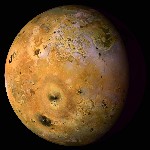Basically, I study planets. Planets with solid surfaces, to be exact. I have degrees in Physics and Astronomy, but the research I do is usually called planetary science, sometimes planetary geophysics. In the past I have studied volcanoes on Venus and hydrothermal systems on Mars. Currently I study moons of planets, mostly those of Jupiter.
I'm one of the Co-Investigators of the Europa - THermal Emission IMaging System (E-THEMIS) instrumment, which, when launched aboard NASA's Europa Clipper spacecraft, will measure surface temperatures at Europa.
 In collaboration with John Spencer at
Southwest Research Institute, I have
been using Galileo Photopolarimeter-Radiometer (PPR) and ground-based
data to study volcanism on Jupiter's moon, Io. Io is the most
volcanically active body in the Solar System, putting out more than 40
times the amount of energy that the Earth does. (And Io is only about
the size of our moon!) Approximately twice a month, using occultation
techniques, I observe Io from the NASA Infrared Telescope Facility
(IRTF) on Mauna Kea in Hawaii. These observations are performed
remotely from my office in California and can be used to monitor the
status of Volcanoes on Io. I generally concentrate on the most
powerful volcano on Io, Loki, which erupts approximately once every
year and a half for several months.
In collaboration with John Spencer at
Southwest Research Institute, I have
been using Galileo Photopolarimeter-Radiometer (PPR) and ground-based
data to study volcanism on Jupiter's moon, Io. Io is the most
volcanically active body in the Solar System, putting out more than 40
times the amount of energy that the Earth does. (And Io is only about
the size of our moon!) Approximately twice a month, using occultation
techniques, I observe Io from the NASA Infrared Telescope Facility
(IRTF) on Mauna Kea in Hawaii. These observations are performed
remotely from my office in California and can be used to monitor the
status of Volcanoes on Io. I generally concentrate on the most
powerful volcano on Io, Loki, which erupts approximately once every
year and a half for several months.In 2002, we found that Loki erupts periodically. Click here for a pdf version of that paper.
In 2006 we refined our model for Loki and developed a quantitative, mathematical model of an overturning lava lake that matched our observations including the end of periodic overturn in 2002 and the new eruption in late 2003. Click here for a pdf verstion of that paper.
In 2004, we published the Galileo PPR results in Icarus. Click here for a pdf version of that paper. Galileo was destroyed in 2003, so no new data will be collected. I am now concentrating on combining PPR data with other Galileo data sets for a more complete understanding of the volcanoes.
In 2006, I hosted an Io Workshop at the University of Redlands.
Nathaniel Rodriguez '11 worked with me during the summer of 2008 and independent studies in 2008-2009 to use the Galileo PPR instrument to search for thermal anomalies on Europa. While none were found, he has determined the thermal properties of Europa's surface.
Emily Dahlberg '10, spent summer 2008 trying to determine how the ridge on Iapetus formed. She was able to disprove that a convection model could create the unique feature.
David Miller '09 worked with me during the summer of 2007 continuing the work of Alicia Barnash comparing tectonic and impact crater interactions on the icy satellites of Saturn.
Nate Papapietro '09 worked with me during the summer of 2007 analyzing short wavelength ground-based data of Io's volcanoes.
Alicia Barnash '08 worked with me during the summer of 2006. We used Cassini imaging data to study the relationship between tectonics and impact craters on icy satellites.
Mara Block '06 worked with me during the summer of 2004 examining the large volume of PPR data in order to pick out those data worthy of further study.
Chase Ellis '06 worked with me during the summer of 2003 looking at mutual occultation data taken at the IRTF in Hawaii.
Steven Johnson '03 studied Jupiter occultations of Io during 2 semesters of independent study and the summer of 2002. This work became his senior thesis.